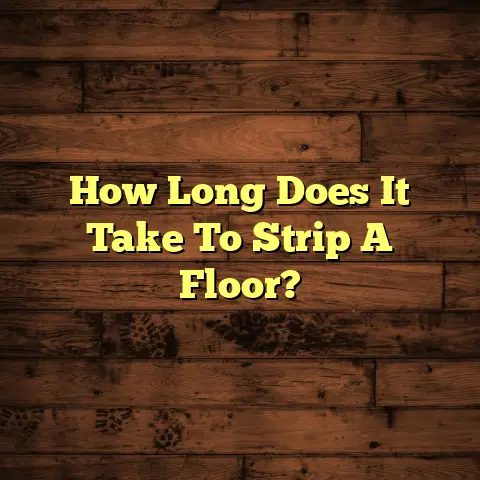Toughest Wood Floor Finish? (1 Coat Wonder!)
Discovering the 1 Coat Wonder!
Ever feel like your beautiful wood floors are in a constant battle against scratches, dents, and the relentless wear of daily life?I get it. You invest time and money in selecting and installing gorgeous hardwood, only to watch it lose its luster.
It’s frustrating, right? That’s why I’m diving deep into a question I hear all the time:
Is there a wood floor finish that can actually withstand the test of time without needing a million coats?
Spoiler alert: there might be! Let’s explore the concept of a “1 Coat Wonder” finish and uncover the toughest options on the market.
Section 1: Understanding Wood
Floor Finishes
So, what are wood floor finishes anyway? Think of them as your floor’s bodyguard. They’re protective layers applied to the surface of your hardwood to shield it from:
- Scratches
- Moisture
- Daily wear and tear
Without a finish, your beautiful wood is vulnerable to damage, staining, and a whole lot of headaches.
There’s a whole world of different types of finishes out there. Let’s break down some of the most common:
- Oil-Based Polyurethane: The classic. Durable, amber-toned, but can yellow over time.
- Water-Based Polyurethane: Clearer finish, lower VOCs (volatile organic compounds), dries faster than oil-based.
- Penetrating Oils (like Tung Oil or Linseed Oil): Soak into the wood, providing a natural look and feel. Requires more maintenance.
- Moisture-Cured Urethane: Super tough and resistant, often used in commercial settings. But it’s stinky and tricky to apply.
- Acid-Cured Urethane (Swedish Finish): Extremely durable and water-resistant. High VOCs, professional application recommended.
Over the years, we’ve seen some serious technological advancements in wood floor finishes. Manufacturers are constantly striving to create products that are:
- More durable
- Easier to apply
- More environmentally friendly
It’s an exciting time to be in the flooring business, let me tell you!
Section 2: The Science Behind Durability
Okay, let’s get a little nerdy for a minute. What actually makes a wood floor finish tough? It’s not just magic, it’s science!
Several factors contribute to a finish’s ability to withstand the daily grind:
- Chemical Composition: The specific ingredients and how they interact determine the finish’s hardness, flexibility, and resistance to chemicals and abrasion.
- Drying Time: Proper curing is crucial. A finish needs enough time to fully harden and bond to the wood for maximum durability.
- Hardness Ratings: The industry uses tests like the “Taber Abrasion Test” and “Pencil Hardness Test” to measure a finish’s resistance to scratching and wear.
I’ve spoken with chemists and flooring scientists who spend their days formulating these finishes. They’re constantly tweaking the recipes to achieve the perfect balance of:
- Hardness
- Flexibility
- Adhesion
Think of it like baking a cake – the right ingredients and baking time are essential for a delicious (and durable) result!
Section 3: The Benefits of a 1 Coat
Wonder Finish
Alright, now we’re getting to the good stuff. What’s the big deal about a 1 coat finish? Why should you even consider it?
Well, let’s be honest, who doesn’t love saving time and money? Here are some key advantages of using a 1 coat finish:
- Time Savings: This is a big one! Fewer coats mean less time spent applying the finish and waiting for it to dry.
- Cost-Effectiveness: Less product needed, less labor involved (if you’re hiring a professional). It all adds up!
- Ease of Application: Generally, 1 coat finishes are designed to be user-friendly, making them a great option for DIYers.
- Simplified Refinishing: When it’s time to refinish, you’ll have less old finish to remove, making the process easier.
I’ve talked to homeowners who were initially skeptical about 1 coat finishes, but after trying them, they were amazed by the results.
“I was hesitant at first,” said Sarah from Chicago. “But the 1 coat finish was so easy to apply, and my floors look fantastic! Plus, I saved a ton of time.”
Section 4: Comparing the Toughest
Wood Floor Finishes
Okay, let’s get down to brass tacks. Which “1 coat wonder” finishes are actually worth your money?
I’ve done my research, and I’m going to share my top picks with you. Keep in mind that the “best” finish depends on your specific needs and preferences.
Here are a few contenders:
- Bona Traffic HD: This is a water-based polyurethane known for its exceptional durability and fast drying time. While technically designed as a multi-coat system, many pros have had success with a robust single coat application for certain situations. Pros: Excellent durability, low VOCs. Cons: Can be pricey.
- Pallmann Magic Oil 2K Pure: This is a two-component oil finish that provides a natural look and feel while offering good protection. It’s designed for a single-coat application. Pros: Natural look, easy to repair. Cons: May require more maintenance than polyurethane.
- Rubio Monocoat Oil Plus 2C: Another oil-based option that’s known for its easy application and unique coloring capabilities. It’s designed as a single-coat system. Pros: Wide range of colors, eco-friendly. Cons: Can be more expensive than other options.
To help you compare these options, here’s a handy table:
| Feature | Bona Traffic HD | Pallmann Magic Oil 2K Pure | Rubio Monocoat Oil Plus 2C |
|---|---|---|---|
| Finish Type | Water-Based Poly | Oil-Based | Oil-Based |
| Durability | Excellent | Good | Good |
| VOC Level | Low | Medium | Low |
| Drying Time | Fast | Medium | Medium |
| Application | Brush/Roller | Trowel/Pad | Trowel/Pad |
| Maintenance | Easy | Moderate | Moderate |
| Price | High | Medium | High |
Important Note: Always check the manufacturer’s instructions and recommendations before applying any finish.
Section 5: Application Techniques for
Maximum Toughness
Even the toughest finish won’t perform well if it’s not applied correctly. Here’s a step-by-step guide to help you achieve optimal results:
- Surface Preparation: This is crucial. Make sure your floors are clean, dry, and free of any dust, dirt, or old finish. Sand the floors properly to create a smooth, even surface for the new finish to adhere to.
- Choose the Right Tools: Use high-quality brushes, rollers, or sprayers recommended by the finish manufacturer. Don’t skimp on this – cheap tools can lead to streaks, bubbles, and other imperfections.
- Application Technique: Apply the finish in thin, even coats, following the grain of the wood. Avoid overlapping or puddling the finish.
- Drying Time: Allow the finish to dry completely according to the manufacturer’s instructions. Don’t rush this process!
- Maintenance: Once the finish is dry, clean your floors regularly with a pH-neutral cleaner recommended for wood floors. Avoid using harsh chemicals or abrasive cleaners.
Here are a few extra tips to keep in mind:
- Test in an Inconspicuous Area: Before applying the finish to the entire floor, test it in a closet or under a piece of furniture to make sure you like the color and finish.
- Ventilation is Key: Make sure the room is well-ventilated during application and drying to avoid inhaling harmful fumes.
- Don’t Over-Apply: More isn’t always better. Applying too much finish can lead to a sticky, uneven surface.
Section 6: Real-Life Applications and
Case Studies
Let’s take a look at some real-world examples of how 1 coat finishes have performed in different settings:
-
The Pet-Friendly Home: John and Mary have two large dogs and were tired of their floors getting scratched and damaged. They used Rubio Monocoat on their red oak floors and were amazed at how well it held up to their furry friends.
-
The High-Traffic Business: A local coffee shop used Bona Traffic HD on their hardwood floors. They needed a durable finish that could withstand heavy foot traffic and spills. The floors still look great after a year of constant use.
These are just a few examples, but they demonstrate the versatility and durability of 1 coat finishes.
Section 7: Common Misconceptions About
Wood Floor Finishes
There are a lot of myths and misconceptions surrounding wood floor finishes. Let’s bust a few of them:
- Myth: More Coats = Better Protection. This isn’t always true. A high-quality finish applied correctly can provide excellent protection, even with just one coat.
- Myth: All Finishes Are the Same. Definitely not! Different finishes have different properties and are designed for different purposes.
- Myth: You Can’t Refinish Wood Floors. Absolutely false! Wood floors can be refinished multiple times to restore their beauty.
Section 8: The Future of Wood Floor
Finishes
The world of wood floor finishes is constantly evolving. Here are a few emerging trends and innovations to keep an eye on:
- UV-Cured Finishes: These finishes cure almost instantly under UV light, reducing drying time and increasing durability.
- Plant-Based Finishes: More and more manufacturers are developing finishes made from renewable resources, like vegetable oils and plant resins.
- Self-Healing Finishes: Imagine a finish that can repair minor scratches and scuffs on its own! This technology is still in its early stages, but it has the potential to revolutionize the industry.
Conclusion:
So, is a tough wood floor finish achievable? Absolutely! And it might just come in the form of a convenient 1 coat application.
Choosing the right product based on your individual needs is essential. A quality finish can have a lasting impact on the beauty and longevity of your hardwood floors.
Don’t be afraid to do your research, ask questions, and experiment with different options. Your floors will thank you for it!




